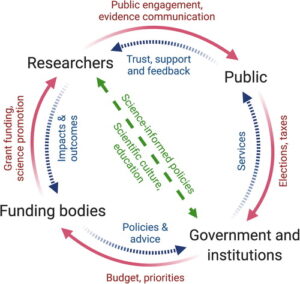Africa
In 2007 the United Nations Educational, Scientific and Cultural Organization (UNESCO) named what it terms the Potential Centres of Excellence in Journalism Training in Africa. After thorough research there were twelve journalism and media training institutions named on the list and they were not placed in any order.
These twelve UNESCO Potential Centres of Excellence in Journalism Training in Africa are the Department of Journalism at the Tshwane University of Technology in Pretoria in South Africa (TUT), Mass Communication Department at Makerere University in Uganda, School of Journalism and Media Studies at Rhodes University in Grahamstown in South Africa, Department of Mass Communication at the University of Lagos in Nigeria, School of Communication, Legal and Secretarial Studies at the Namibia Polytechnic, Mozambican School of Journalism in Mozambique, Centre d’études des sciences et techniques de l’information in Senegal, The School of Journalism and Mass Communication at the University of Nairobi in Kenya, Department of Journalism at the University of Stellenbosch in South Africa, Institut Supérieur de l’Information et de la Communication in Morocco, School of Communication Studies at Walter Sisulu University in South Africa and Ecole Supérieure de Sciences et Techniques de l’Information et de la Communication in Cameroon.
UNESCO’s list is not exhaustive, and new schools have been founded since the study was conducted.
With the rise of Internet and social media in the past five years there has been increasing demand for journalism schools offering specialized training in the kinds of modern challenges journalists face in the rapidly changing online-media landscape. E-jicom Graduate School of Journalism and Communication in Dakar, Senegal is one such institution.
Asia
The most populous continent is also home to the world’s largest democracy and its pace of growth and booming economies have led to a proliferation of media enterprises. The rise of digital publishing has created newer opportunities for employment and self-employment in the field of journalism and mass communication.
India
Unlike the rest of the world, print media continues to grow and thrive in India with its over 1.4 billion people. With over 900 TV channels and over 100,000 100,000 registered publications, digital publishing has only added to the opportunities. Dozens of regional languages and English being the aspirational language, newspapers in India are now published in 100 different languages. The government of India established the “Indian Institute of Mass Communication (IIMC)” in 1965, which has now 6 campuses across India. Dozens of universities and independent institutes provide education for shaping journalism, media and mass communication professionals.
Pakistan
Pakistan is a large country of South Asia with a population almost 220 million people. It has all contemporary media i.e. print, electronic and social media widely used by the citizens. Each public and private university has established separate institute for imparting education in mass communication, journalism and media. Recently the Government of Pakistan has promulgated Protection of Journalists and Media Professionals Act 2021 in order to provide more safe and conducive working environment to the local as well as international journalists.
Europe
Central Europe
The International Media Center (Slovenia-Austria-Serbia), offers in cooperation with South East Europe Media Organisation (SEEMO) and South East and Central Europe PR Organisation (SECEPRO) several courses, including master programme.
In Hungary, The Hungarian Bálint György Academy of Journalism (previously known as Hungarian School of Journalism) runs under the aegis of the National Association of Hungarian Journalists (MÚOSZ). Before 1989, the Hungarian School of Journalism served as a highly selective post-graduate program for well-trained journalists in Hungary. Since 2003, the Bálint György Academy of Journalism belongs to the accredited professional education system.
Budapest Metropolitan University was established as Budapest College of Communication in 2000 and has been providing students with journalism, communication, and media studies classes. The school is also in partnership with the Hungarian Public Television (MTVA).
Denmark
In Denmark, the University of Southern Denmark established a journalism study programme in 1998 at the then founded Centre for Journalism, as did Roskilde University, following the political decision to break the Danish School of Journalism’s monopoly on educating journalists in Denmark. The purpose was and is to increase the diversity of teaching and research within the field of journalism. Since its establishment, the Centre for Journalism has launched several innovative features within the field, including the by now renowned award for journalists, “The Journalistic Fellowship”, and the introduction of a journalist’s oath similar to the Hippocratic oath. Also, in terms of scientific publications it is the most productive journalism research department in Denmark (status: 2005).
Eastern Europe
In Russia, the MSU Faculty of Journalism is the leading journalism school and the world’s largest school of journalism. The majority of textbooks on journalism in Russian were written by MSU scientists.
In Minsk (Belarus), the Institute of Journalism of BSU is one of the leading scientific and educational centers in the sphere of Mass Media in the territory of the former soviet countries. It possesses a highly respected scientific and pedagogical standard and prepares professionals in mass media for work in Belarus and abroad.
France
In France, 14 schools are recognized by the profession at the national level. The Centre de Formation des Journalistes de Paris (CFJ[ in partnership with Panthéon-Sorbonne University) was founded in 1946 by two Resistance leaders, although École supérieure de journalisme de Lille had been founded earlier (1924).# ISO CERTIFICATION IN iNDIA
Other Parisian journalism schools are Sciences Po Journalism School, CELSA – Sorbonne University, Institut français de presse – Panthéon-Assas University (IFP) and Institut Pratique du Journalisme – PSL University (IPJ).

In the different French regions : Ecole de journalisme de Toulouse (EjT), Institut du Journalisme de Bordeaux-Aquitaine (IJBA), Ecole de journalisme et de communication d’Aix-Marseille University (EJCAM), Centre universitaire d’enseignement du journalisme – University of Strasbourg (CUEJ) in Strasburg or Ecole de journalisme de Grenoble – Grenoble Alpes University (EJDG).
Founded in 1899, the Ecole Supérieure de Journalisme in Paris, France is a claimant for the title of the first journalism school.
Germany
During the Third Reich, the Nazis established the Reichspresseschule (Imperial School of Press), in which journalists were taught to write what the National Socialist German Workers’ Party wanted the German public to think.# ISO CERTIFICATION IN iNDIA
After the war, the first journalism school in Germany was founded in 1949 as Werner Friedmann Institute. 1961 the school’s name was changed into Deutsche Journalistenschule (German school of journalism). In 1979, a new journalism school was created in Hamburg, later renamed after the founder of Stern magazine, Henri Nannen.# ISO CERTIFICATION IN iNDIA
Spain
The top journalism school in Spain according to El Mundo newspaper is the University of Navarra. It is the oldest school of journalism in Spain and among the top 10 world universities of medium size according to the QS ranking. Many reputed and well-known journalists have studied at Universidad Complutense de Madrid, one of Madrid’s most prestigious university. Princess Letizia of Spain studied journalism at this university, which is the main public university in the country. Other universities include Carlos III university, Pompeu Fabra University, Autonomous University of Barcelona and Pontifical University of Salamanca.# ISO CERTIFICATION IN iNDIA
United Kingdom
Historically, in the United Kingdom entrants used first to complete a non-media-studies related degree course, giving maximum educational breadth, prior to taking a specialist postgraduate pre-entry course. However, this has changed in recent years with journalism training and education moving to higher educational institutions. There are now over 60 universities in the UK offering BA honours degrees in journalism. Postgraduate courses are more well-established, some of which are either recognised by the National Union of Journalists (NUJ) or the National Council for the Training of Journalists (NCTJ). A Diploma of Journalism was established at London University in 1919, but university journalism education in Britain did not become a significant endeavour until the 1970s, with establishment of the University of Wales postgraduate program.Most training from the mid-20th century was run by the National Council for the Training of Journalists.
The Department of Journalism Studies at the University of Sheffield is rated Number 1 in the UK by the Guardian (2019) for Journalism, Publishing & Public Relations, and number 1 in the UK by the Times/Sunday Times (2018) for Communication and Media Studies.[ The National Student Survey results for both 2009 and 2010 placed The University of Sheffield No. 1 in the UK for overall satisfaction with Journalism Studies.# ISO CERTIFICATION IN iNDIA
Of City University London’s Journalism Department The Independent commented that City’s postgraduate courses had “rightly accrued legendary status within the media. Former Guardian editor Peter Preston wrote: “What’s the passport to journalism? The dreaming spires of… City University”.City’s faculty includes Professors George Brock and Roy Greenslade. Alumni include Sophie Raworth of the BBC, Sky’s Dermot Murnaghan and Channel 4 News Economics Editor Faisal Islam.
Another well-established course is the highly regarded School of Journalism, Media and Cultural Studies at Cardiff University which was founded in 1970 by Tom Hopkinson. The course was also the UK’s top-rated course by the National Council for the Training of Journalists for the academic year 2007/8.
The University of Kent’s Centre for Journalism was established with Professor Tim Luckhurst as the first head. The Centre runs both undergraduate and postgraduate degrees that are accredited by the National Council for the Training of Journalists. and the Broadcast Journalism Training Council. The Centre offers guaranteed work placements with the KM Group. It was ranked best for undergraduate study of journalism in The Guardian‘s University Guide for 2015, and in The Times Good University Guide 2016 in which it was ranked first for graduate employment prospects in journalism.
One of Europe’s longest established centres of journalism education is the department of Journalism, Media and Communication, University of Central Lancashire (also known as UCLan), which launched its first print journalism course in 1962 at the then Harris College, which later became part of the University of Central Lancashire. Of the school, a 2008 article in The Times observed that “it is acknowledged as one of the leading centres for the teaching of journalism in Britain”. In 2010, the University won the Broadcast Journalism Training Council’s award for general excellence.






